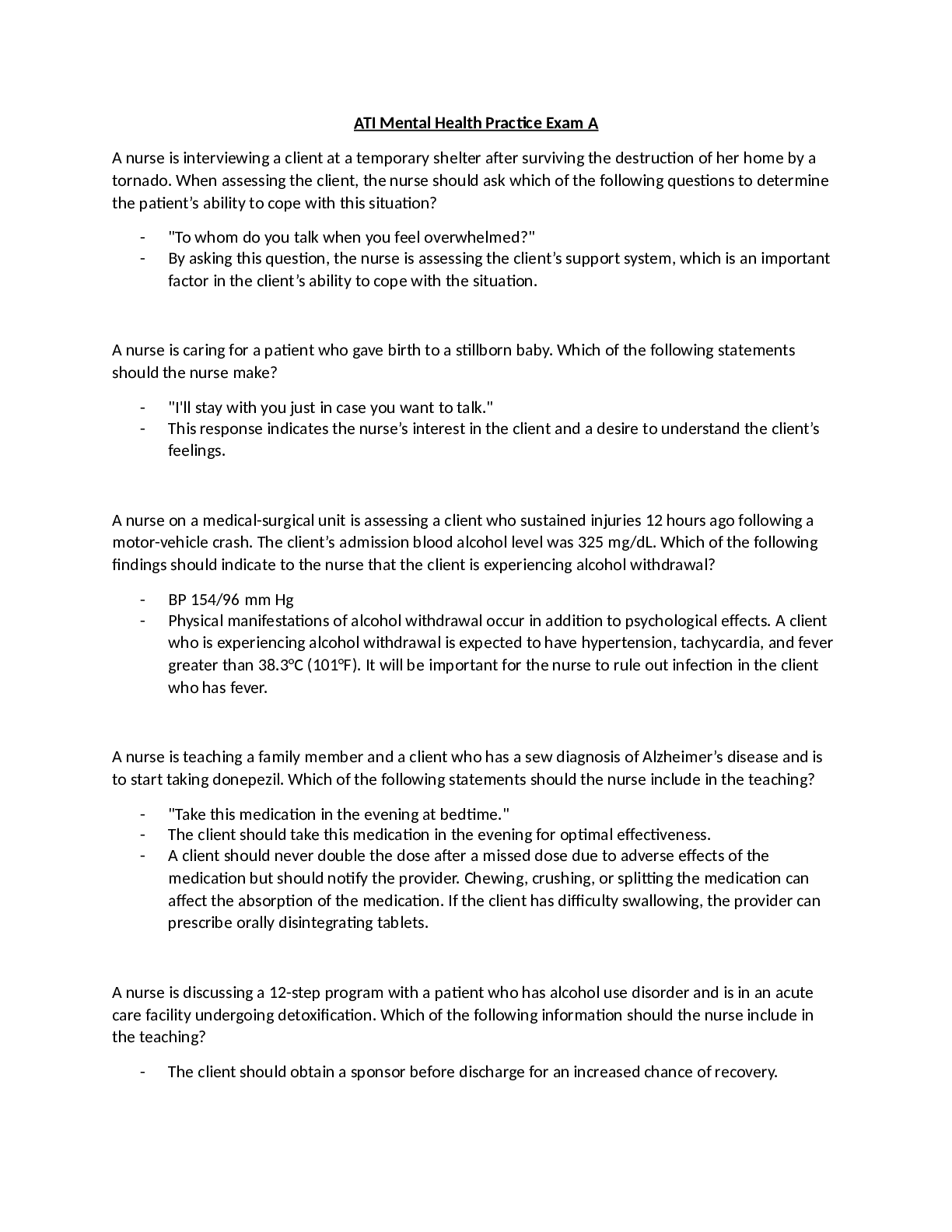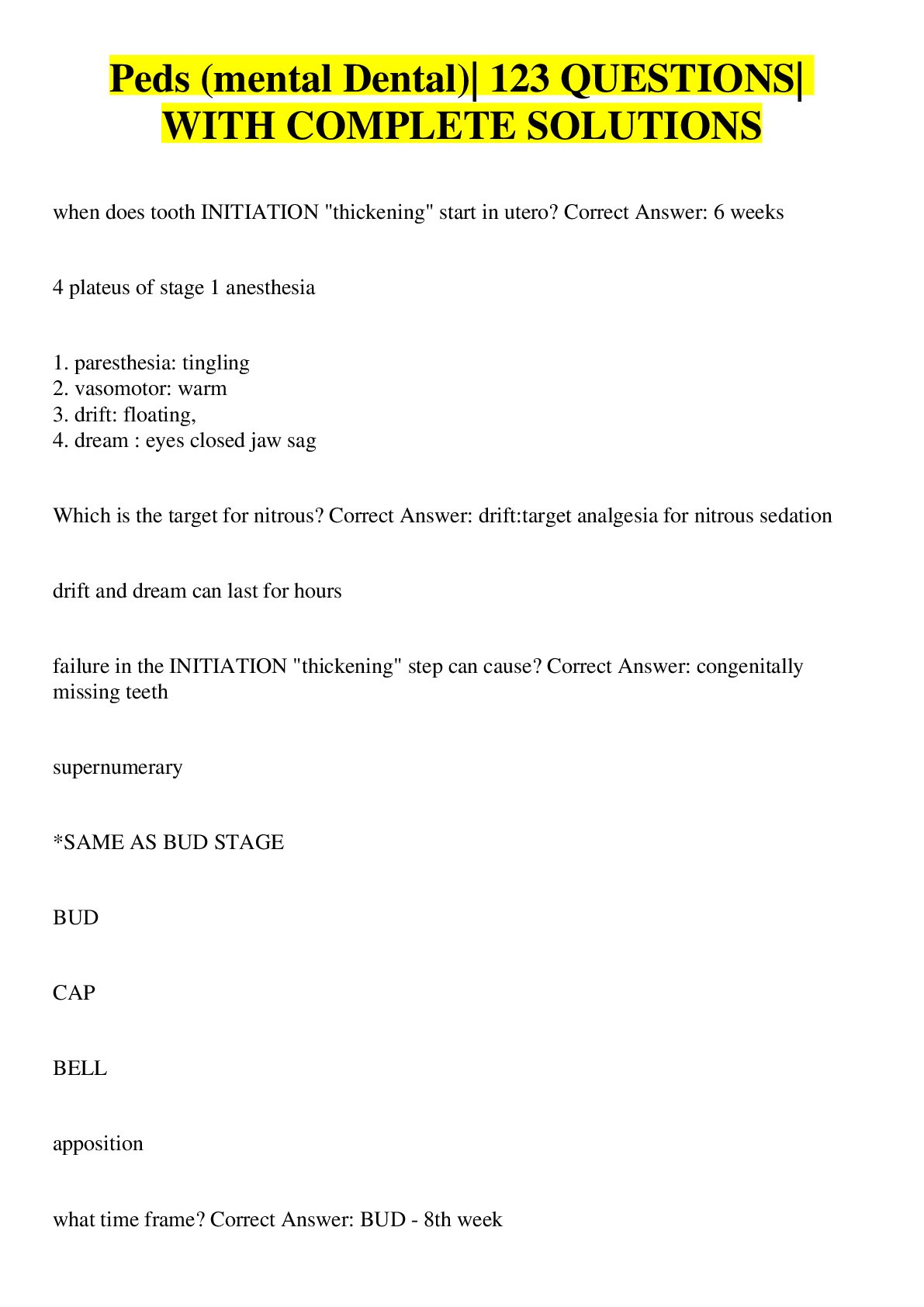Paediatrics > ATI > Peds- ATI Practice Exam A (All)
Peds- ATI Practice Exam A
Document Content and Description Below
Peds- ATI Practice Exam A A nurse in an urgent care clinic is assessing an adolescent who has an upper respiratory tract infection. Which of the following findings should the nurse identify as a man... ifestation of pertussis? - Dry, hacking cough Rationale: The nurse should identify that a dry, hacking cough is a manifestation of pertussis. This disease usually begins with indications of an upper respiratory tract infection, which includes a dry, hacking cough that is sometimes more severe at night. A nurse is caring for a school-age child who is receiving a blood transfusion. Which of the following manifestations should alert the nurse to a possible hemolytic transfusion reaction? - Flank pain Rationale: The nurse should recognize that flank pain is caused by the breakdown of RBCs and is an indication of a hemolytic reaction to the blood transfusion. A nurse is caring for a school-age child who is receiving cefazolin via intermittent IV bolus. The child suddenly develops diffuse flushing of the skin and angioedema. After discontinuing the medication infusion, which of the following medications should the nurse administer first? - Epinephrine Rationale: This child is most likely experiencing an anaphylactic reaction to the cefazolin. According to evidence-based practice, the nurse should first administer epinephrine to treat the anaphylaxis. Epinephrine is a beta adrenergic agonist that stimulates the heart, causes vasoconstriction of blood vessels in the skin and mucous membranes, and triggers bronchodilation in the lungs. A nurse is teaching the guardian of a 6-month-old infant about car seat use. Which of the following statements by the guardian indicates an understanding of the teaching? - "I should secure the car seat using lower anchors and tethers instead of the seat belt." Rationale: Lower anchors and tethers, or the LATCH child safety seat system, should be used to secure an infant's car seat in the vehicle. This system provides anchors between the front cushion and the back rest for the car seat. Therefore, if this system is available, the seat belt does not have to be used.A nurse is planning care for a toddler who has a serum lead level of 4 mcg/dL. Which of the following actions should the nurse plan to take? - Schedule the toddler for a yearly rescreening. Rationale: The nurse should schedule the toddler for a lead level rescreening in 1 year and educate the family on ways to prevent exposure. A nurse is caring for a toddler who has spastic (pyramidal) cerebral palsy. Which of the following findings should the nurse expect? (Select all that apply.) - -Ankle clonus -Exaggerated stretch reflexes -Contractures A nurse is assessing a school-age child immediately following a perforated appendix repair. Which of the following findings should the nurse expect? - Absence of peristalsis Rationale: The nurse should expect absence of peristalsis immediately following a perforated appendix repair, until the bowel resumes functioning. A nurse is planning care for a school-age child who is in the oliguric phase of acute kidney injury (AKI) and has a sodium level of 129 mEq/L. Which of the following interventions should the nurse include in the plan? - Initiate seizure precautions for the child. Rationale: A sodium level of 129 mEq/L indicates hyponatremia and places the child at increased risk for neurological deficits and seizure activity. The nurse should complete a neurologic assessment and implement seizure precautions to maintain the child's safety. A nurse is teaching the parent of an infant who has a Pavlik harness for the treatment of developmental dysplasia of the hip. The nurse should identify that which of the following statements by the parent indicates an understanding of the teaching? - "I will place my infant's diapers under the harness straps." Rationale: To prevent soiling of the harness, the parent should apply the infant's diaper under the straps.A nurse is reviewing the laboratory report of a school-age child who is experiencing fatigue. Which of the following findings should the nurse recognize as an indication of anemia? - Hematocrit 28% Rationale: The nurse should recognize that this hematocrit level is below the expected reference range of 32% to 44% for a school-age child. The child can exhibit fatigue, lightheadedness, tachycardia, dyspnea, and pallor due to the decreased oxygen-carrying capacity. [Show More]
Last updated: 2 years ago
Preview 1 out of 14 pages
.png)
Buy this document to get the full access instantly
Instant Download Access after purchase
Buy NowInstant download
We Accept:

Reviews( 0 )
$10.00
Can't find what you want? Try our AI powered Search
Document information
Connected school, study & course
About the document
Uploaded On
Jul 23, 2022
Number of pages
14
Written in
Additional information
This document has been written for:
Uploaded
Jul 23, 2022
Downloads
0
Views
348
.png)

.png)
.png)
.png)
.png)
.png)
.png)

.png)
.png)
.png)
.png)
.png)




